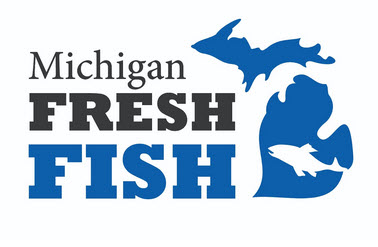What is Mi Fresh Fish?
COVID-19 funds launch of a Michigan fisheries consumer educational marketing campaign.

This comment from a Michigan seafood wholesaler highlights a common problem: We do not sell any Michigan farm-raised fish and are only able to get Michigan lake whitefish from the UP only a couple times each summer. The yellow perch and walleye we sell comes to us from Canada. In fact, approximately 90% of the seafood consumed in the U.S. is imported. Despite a recommendation from the U.S. Health and Human Services to eat fish more than once each week, less than 20 percent of Michiganders make it a regular part of their weekly diet. Not only is there not enough local fish produced to meet our food demand, but Michiganders are missing out on finding and understanding the benefits of eating healthy, local, fresh fish. 
The current Michigan fish landscape includes small and mighty industries that feed the people of Michigan. These industries include: aquaculture (or fish farming), commercial fishing, and seafood processing industries. In 2020, federal funds were allocated to the Great Lakes for COVID-19 relief in support for these industries. A portion of the funds have been allocated to a consumer education marketing campaign, called Mi Fresh Fish.
What is Mi Fresh Fish?
Mi Fresh Fish uplifts all fish produced in Michigan. This includes fish produced from farmed and wild harvests for food, bait, stocking, fee-fishing, or ornamental products. The goal is to educate and bring awareness to Michiganders that aquaculture, commercial fishing, and seafood processing industries exist in Michigan and that they are not just businesses, but also our neighbors. Mi Fresh Fish is a brand that unites all Michigan-produced fish under the same message - especially creating access to fish for food. Mi Fresh Fish includes the broader Michigan seafood supply chain that includes Tribal commercial fishing, seafood processors, retail and wholesale fish markets, and those who buy Michigan-produced fish.
Farm-raised fish and bait supplies
As a recreational-focused managed fishery in Michigan, it’s also important to understand that recreational fishers are also influenced by these industries. Bait shops for minnows and stocking for backyard ponds or fishing clubs are mostly supplied through aquaculture businesses. Federal, state, and Tribal hatcheries are in fact aquaculture, as a hatchery is just the system used to raise fish from an egg to the size of a fingerling (a small fish up to the size of a finger). These stocked, or planted, fish were raised using aquaculture to support recreational and subsistence fisheries.
Do you know where your fish comes from?
The fish supplied by grocery stores or restaurants can only come from commercial industries, or aquaculture and commercial fishing. Mi Fresh Fish provides an opportunity for Michiganders to learn more about where to find local suppliers for all their needs, including eating and enjoying fish on a regular basis. Education for those in the fisheries supply chain as well as consumers is just as important.
Ad campaign begins
Michigan Sea Grant is working collaboratively with fish producers on the Mi Fresh Fish educational marketing campaign. An advertising campaign began in January 2023 using Google ads and later adding promotion on social media. These ads reinforce the benefits of eating Michigan fish as well attributes of Michigan fish farmers and commercial fishers. Click on an ad, and you will find more information and resources online. The ads are proving to be popular. Within the first 3 months, there have been more than 234,000 clicks by people interested in learning more about Michigan fresh fish. If you would like to learn more, dive in and visit Mi Fresh Fish online!
Michigan Sea Grant helps to foster economic growth and protect Michigan’s coastal, Great Lakes resources through education, research, and outreach. A collaborative effort of the University of Michigan and Michigan State University and its MSU Extension, Michigan Sea Grant is part of the NOAA-National Sea Grant network of 34 university-based programs.
This article was prepared by Michigan Sea Grant under award NA180AR4170102 from the National Oceanic and Atmospheric Administration, U.S. Department of Commerce through the Regents of the University of Michigan. The statement, findings, conclusions, and recommendations are those of the author(s) and do not necessarily reflect the views of the National Oceanic and Atmospheric Administration, the Department of Commerce, or the Regents of the University of Michigan.



 Print
Print Email
Email

